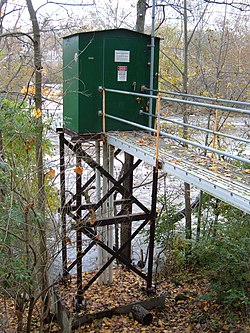United States Geological Survey: Difference between revisions
m sp: an vigorous→a vigorous |
Changed budget $ to FY 2006 enacted budget |
||
| Line 10: | Line 10: | ||
|'''Director:'''|| Mark Myers |
|'''Director:'''|| Mark Myers |
||
|- |
|- |
||
|'''Budget:'''||$ |
|'''Budget:'''||$971 million (FY2006) |
||
|- |
|- |
||
|'''Employees:'''|| 10,000 (2004) |
|'''Employees:'''|| 10,000 (2004) |
||
Revision as of 14:54, 18 January 2007
| Established: | March 3, 1879 |
| Director: | Mark Myers |
| Budget: | $971 million (FY2006) |
| Employees: | 10,000 (2004) |
The United States Geological Survey (USGS) is a scientific agency of the United States government. The scientists of the USGS study the landscape of the United States, its natural resources, and the natural hazards that threaten it. The organization has four major science disciplines, concerning biology, geography, geology, and hydrology. The USGS is a fact-finding research organization with no regulatory responsibility.
A bureau of the United States Department of the Interior, it is that department's sole scientific agency. The USGS employs approximately 10,000 people and is headquartered in Reston, Virginia, with major offices in Denver, Colorado, and Menlo Park, California.
History
Prompted by a report from the National Academy of Sciences the USGS was created by an act of Congress on March 3, 1879. It was charged with the "classification of the public lands, and examination of the geological structure, mineral resources, and products of the national domain." This task was driven by the need to inventory the vast lands added to the United States by the Louisiana Purchase in 1803.
Clarence King, the first director of USGS, assembled the new organization from disparate regional survey agencies. After a short tenure, King was succeeded in the director's chair by John Wesley Powell.
The complete list of Directors:
- 1879–1881 Clarence King
- 1881–1894 John Wesley Powell
- 1894–1907 Charles Doolittle Walcott
- 1907–1930 George Otis Smith
- 1930–1943 Walter Curran Mendenhall
- 1943–1956 William Embry Wrather
- 1956–1965 Thomas Brennan Nolan
- 1965–1971 William Thomas Pecora
- 1971–1978 Vincent Ellis McKelvey
- 1978–1981 Henry William Menard
- 1981–1993 Dallas Lynn Peck
- 1994–1997 Gordon P. Eaton
- 1998–2005 Charles G. Groat
- 2006-present Mark Myers
Mission

The USGS is the primary civilian mapping agency in the United States, and is best known for its 1:24,000 scale, 7.5-minute quadrangle topographic maps. Their recent program, the National Map, is an attempt to be the ultimate online mapping service for the United States. The USGS also has a vigorous Business Partners program through which they encourage the reselling of their maps so that the public can have quicker, easier access to information. Many commercial sites such as TopoZone have capitalized on this program to provide web mapping services in conjunction with the USGS.
The USGS Earthquake Hazards Program monitors earthquake activity worldwide. The National Earthquake Information Center (NEIC) in Golden, Colorado on the campus of the Colorado School of Mines detects the location and magnitude of global earthquakes. The USGS also runs or supports several regional monitoring networks in the U.S. under the umbrella of the Advanced National Seismic System (ANSS). The USGS informs authorities, emergency responders, the media, and the public, both domestic and worldwide, about significant earthquakes. It also maintains long-term archives of earthquake data for scientific and engineering research. It also conducts and supports research on long-term seismic hazards.
The USGS National Geomagnetism Program monitors the magnetic field at magnetic observatories and distributes magnetometer data in real time.
Since 1962, it has been involved in global, lunar and planetary exploration and mapping.
The USGS also operates the National Wildlife Health Center, whose mission is "to serve the nation and its natural resources by providing sound science and technical support, and to disseminate information to promote science-based decisions affecting wildlife and ecosystem health. The NWHC provides information, technical assistance, research, education, and leadership on national and international wildlife health issues." [1] It is the agency primarily responsible for surveillance of wild-animal H5N1 avian flu outbreaks in the United States.
As of 2005, the agency is working to create a National Volcano Early Warning System by improving the instrumentation monitoring the 169 volcanoes in U.S. territory and by establishing methods for measuring the relative threats posed at each site.
The motto of the USGS is "Science for a changing world."
The USGS also runs 17 biological research centers in the United States, including the Patuxent Wildlife Research Center.
Publishing and Censorship
In December 2006 it was announced that the rules for the publication of USGS research were changing. From now on the USGS communications office must be notified in advance "of findings or data that may be especially newsworthy, have an impact on government policy, or contradict previous public understanding to ensure that proper officials are notified and that communication strategies are developed." The agency leadership has stated that these changes are simply to maintain the scientific integrity of the agency's work; however, scientists have questioned whether this policy will lead to censorship of their work. [2]
See also
- Geographic Names Information System
- Volcano Disaster Assistance Program
- Timeline of environmental events
- Maps of the United States
- British Geological Survey
- Saudi Geological Survey
External links
USGS sites
- USGS official site
- Major USGS Discipline sites: Water, Geology, Geography, Biology
- USGS science programs
- Science Topics (thematic directory)
- Science in Your Backyard (State index)
- USGS Natural Hazards Gateway
- USGS Circular 1050 (History of the USGS)
- USGS Geomagnetism Program
- Earthquake Hazards Program (current and historical earthquake information)
- Subscribe to automated earthquake messages
- Volcano Information
- The Libre Map Project offers free, high-quality USGS DRG maps in TIFF format along with world files for use with your GIS software
- TerraServer-USA and TopoZone host USGS topographic maps (and aerial photos on TerraServer-USA); Maptech hosts historical USGS topos in the northeast U.S.


